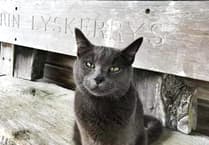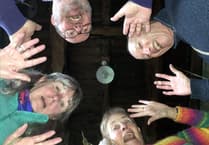Nature photographer Ray Roberts makes do with a short village walk on a wet day - and when the sun comes out, it’s a treat to see some busy insects at last...
If the weather is very wet, I make do with a walk around the village and was surprised, last week, to see some summer snowflake – Leucojum aestivum - flowers on the edge of a garden beside the road. Apart from being cultivated in gardens, these flowers can sometimes be seen growing on marshland and beside streams and, despite its name, usually appear during early to mid-spring.
Nearby was an old concrete mixer that had probably mixed hundreds of tons of sand, gravel and cement in its day, but now retired and overgrown with vegetation. If it had any kind of label attached to it, I think it would have said ‘Done mixing’.
There were lots of moss covered hazel twigs on the hedges around Quethiock and they always remind me of the fir trees that television artist, Bob Ross, paints in his very enjoyable programmes entitled The Joy of Painting. Lots of these very small ‘fir trees’ can be seen around the village.
A robin appeared down on the hedge creep and was poking around beneath the fallen leaves as I was walking towards Hepwell Farm. Now, robins must be the most familiar and popular birds of gardens and country lanes and, of course, one of the easiest to recognise. It kept moving ahead of me as it searched for insects, small worms, spiders and centipedes, not at all frightened as I walked slowly behind it. Then it flew up and settled on some short hazel twigs on the hedge giving me a real good look at its plump body. I think this was probably quite a young bird that was still moulting its buff coloured juvenile breast feathers before acquiring its full orange-red chest.
What a good sunny day we had last Monday, completely different from the previous miserable days of constant rain. The morning started well as when I opened up my garden shed, I found I had a German visitor climbing up the window frame.
It was a German wasp of course and I think it spent the winter on or beneath, one of the many shelves and was looking for a way out. After I had taken its photo it found the doorway and was gone. The German wasp can be recognised by the pattern of tiny black markings on its yellow face, whereas the Common wasp has an anchor shaped pattern there. Both species are social insects living in colonies of hundreds, sometimes thousands, of individuals.
On my walk that morning I spotted more that a dozen honey bees at work collecting pollen from the flowers of lesser celandine and daffodils. It was a treat to see some busy insects at last.




